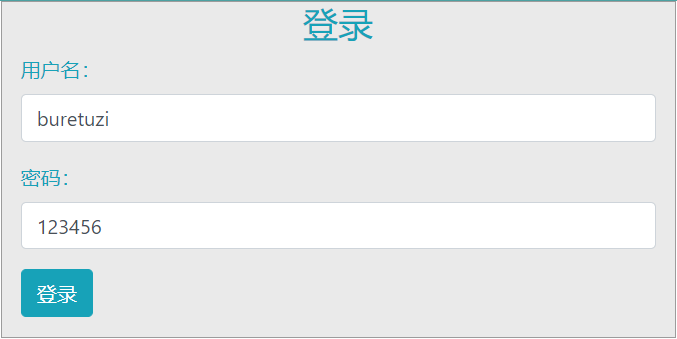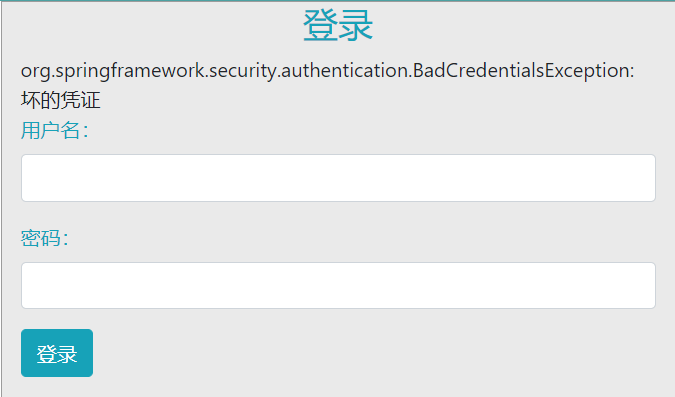1. 登录表单配置
1.1 快速入门
理解了入门案例之后,接下来我们再来看一下登录表单的详细配置,首先创建一个新的Spring Boot项目,引入Web和Spring Security依赖,代码如下:
<dependency>
<groupId>org.springframework.boot</groupId>
<artifactId>spring-boot-starter-security</artifactId>
</dependency>
<dependency>
<groupId>org.springframework.boot</groupId>
<artifactId>spring-boot-starter-web</artifactId>
</dependency>项目创建好之后,为了方便测试,需要在application.yml中添加如下配置,将登录用户名和密码固定下来:
spring:
security:
user:
name: buretuzi
password: 123456接下来,我们在resources/static目录下创建一个login.html页而,这个是我们自定义的登录页面:
查看代码
<!DOCTYPE html>
<html lang="en">
<head>
<meta charset="UTF-8">
<title>登录</title>
<link href="//maxcdn.bootstrapcdn.com/bootstrap/4.1.1/css/bootstrap.min.css" rel="stylesheet" id="bootstrap-css">
<script src="//maxcdn.bootstrapcdn.com/bootstrap/4.1.1/js/bootstrap.min.js"></script>
<script src="//cdnjs.cloudflare.com/ajax/libs/jquery/3.2.1/jquery.min.js"></script>
</head>
<style>
#login .container #login-row #login-column #login-box {
border: 1px solid #9c9c9c;
background-color: #EAEAEA;
}
</style>
<body>
<div id="login">
<div class="container">
<div id="login-row" class="row justify-content-center align-items-center">
<div id="login-column" class="col-md-6">
<div id="login-box" class="col-md-12">
<form id="login-form" class="form" action="/dologin" method="post">
<h3 class="text-center text-info">登录</h3>
<div class="form-group">
<label for="username" class="text-info">用户名:</label><br>
<input type="text" name="uname" id="username" class="form-control">
</div>
<div class="form-group">
<label for="password" class="text-info">密码:</label><br>
<input type="text" name="passwd" id="password" class="form-control">
</div>
<div class="form-group">
<input type="submit" name="submit" class="btn btn-info btn-md" value="登录">
</div>
</form>
</div>
</div>
</div>
</div>
</div>
</body>
</html>这个logmt.html中的核心内容就是一个登录表单,登录表单中有三个需要注意的地方,
- form的action,这里给的是/doLogin,表示表单要提交到/doLogin接口上。
- 用户名输入框的name属性值为uname,当然这个值是可以自定义的,这里采用了uname。
- 密码输入框的name属性值为passwd, passwd也是可以自定义的。
login.html定义好之后,接下来定义两个测试接口,作为受保护的资源。当用户登录成功 后,就可以访问到受保护的资源。接口定义如下:
package com.intehel.demo.controller;
import org.springframework.web.bind.annotation.RequestMapping;
import org.springframework.web.bind.annotation.RestController;
@RestController
public class LoginController {
@RequestMapping("/index")
public String index(){
return "login";
}
@RequestMapping("/hello")
public String hello(){
return "hello";
}
}最后再提供一个Spring Security的配置类:
package com.intehel.demo.config;
import org.springframework.context.annotation.Configuration;
import org.springframework.security.config.annotation.web.builders.HttpSecurity;
import org.springframework.security.config.annotation.web.configuration.WebSecurityConfigurerAdapter;
@Configuration
public class SecurityConfig extends WebSecurityConfigurerAdapter {
@Override
protected void configure(HttpSecurity http) throws Exception {
http.authorizeRequests()
.anyRequest().authenticated()
.and()
.formLogin()
.loginPage("/loginNew.html")
.loginProcessingUrl("/doLogin")
.defaultSuccessUrl("/index")
.failureUrl("/loginNew.html")
.usernameParameter("uname")
.passwordParameter("passwd")
.permitAll()
.and()
.csrf().disable();
}
}在Spring Security中,如果我们需要自定义配置,基本上都是继承自WebSecurityConfigurerAdapter来实现的,当然WebSecurityConfigurerAdapter本身的配置还是比较复杂,同时也是比较丰富的,这里先不做过多的展开,仅就结合上面的代码来解释,在下节中将会对这里的配置再做更加详细的介绍。
- 首先configure方法中是一个链式配置,当然也可以不用链式配置,每一个属性配置完毕后再从重新开始写起
- authorizeRequests()方法表示开启权限配置(该方法的含义其实比较复杂,在后面还会再次介绍该方法),.anyRequest().authenticated()表示所有的请求都要认证之后才能访问.
- 有的读者会对and()方法表示疑惑,and()方法会返回HttpSecurityBuilder对象的一个 子类(实际上就是HttpSecurity),所以and()方法相当于又回到HttpSecurity实例,重新开启 新一轮的配置。如果觉得and()方法很难理解,也可以不用and()方法, 在.anyRequest().authenticated。配置完成后直接用分号(;)结束,然后通过http.formLogin()继续配置表单登录。
- formLogin()表示开启表单登录配置,loginPage用来配置登录页面地址; loginProcessingUrl用来配置登录接口地址;defaultSuccessUrl表示登录成功后的跳转地址; failureUrl表示登录失败后的跳转地址;usernameParameter表示登录用户名的参数名称; passwordParameter表示登录密码的参数名称;permitAll表示跟登录相关的页面和接口不做拦截, 直接通过。需要注意的是,loginProcessingUrl、usernameParameter、passwordParameter 需要和login-html中登录表单的配置一致。
- 最后的csrf().disable()表示禁用CSRF防御功能,Spring Security自带了 CSRF防御机制,但是我们这里为了测试方便,先将CSRF防御机制关闭,在后面将会详细介绍CSRF攻击与防御问题。
配置完成后,启动Spring Boot项目,浏览器地址栏中输入http://localhost:8080/index,会自动跳转到http://localhost:8080/loginNew.html页面,如图2-5所示。输入用户名和密码进行登录(用 户名为buretuzi,密码为123456),登录成功之后,就可以访问到index页面了,如图2-6所示。

图2-5

图2-6
经过上面的配置,我们已经成功自定义了一个登录页面出来,用户在登录成功之后,就可以访问受保护的资源了。
1.2 配置细节
当然,前面的配置比较粗糙,这里还有一些配置的细节需要和读者分享一下。
在前面的配置中,我们用defaultSuccessUrl表示用户登录成功后的跳转地址,用failureUrl 表示用户登录失败后的跳转地址。关于登录成功和登录失败,除了这两个方法可以配置之外, 还有另外两个方法也可以配置。
1.2.1 登录成功
当用户登录成功之后,除了 defaultSuccessUrl方法可以实现登录成功后的跳转之外, successForwardUrl也可以实现登录成功后的跳转,代码如下:
@Configuration
public class SecurityConfig extends WebSecurityConfigurerAdapter {
@Override
protected void configure(HttpSecurity http) throws Exception {
http.authorizeRequests()
.anyRequest().authenticated()
.and()
.formLogin()
.loginPage("/loginNew.html")
.loginProcessingUrl("/doLogin")
.successForwardUrl("/index")
.failureUrl("/loginNew.html")
.usernameParameter("uname")
.passwordParameter("passwd")
.permitAll()
.and()
.csrf().disable();
}
}defaultSuccessUrl 和 successForwardUrl 的区别如下:
- defaultSuccessUrl表示当用户登录成功之后,会自动重定向到登录之前的地址上, 如果用户本身就是直接访问的登录页面,则登录成功后就会重定向到defaultSuccessUrl指定的页面中。例如,用户在未认证的情况下,访问了/hello页面,此时会自动重定向到登录页面, 当用户登录成功后,就会自动重定向到/hello页面;而用户如果一开始就访问登录页面,则登录成功后就会自动重定向到defaultSuccessUrl所指定的页面中,
- successForwardUrl则不会考虑用户之前的访问地址,只要用户登录成功,就会通过服务器端跳转到successForwardUrl所指定的页面
- defaultSuccessUrl有一个重载方法,如果重载方法的第二个参数传入true,则 defaultSuccessUrl的效果与successForwardUrl类似,即不考虑用户之前的访问地址,只要登录成功,就重定向到defaultSuccessUrl所指定的页面。不同之处在于,defaultSuccessUrl是通过重定向实现的跳转(客户端跳转),successForwardUrl则是通过服务器端跳转实现的。
无论是 defaultSuccessUrl 还是 successForwardUrl,最终所配置的都是 AuthenticationSuccessHandler接口的实例。
Spring Security中专门提供了 AuthenticationSuccessHandler接口用来处理登录成功事项:
public interface AuthenticationSuccessHandler {
default void onAuthenticationSuccess(HttpServletRequest request,
HttpServletResponse response, FilterChain chain, Authentication authentication)
throws IOException, ServletException{
onAuthenticationSuccess(request, response, authentication);
chain.doFilter(request, response);
}
void onAuthenticationSuccess(HttpServletRequest request,
HttpServletResponse response, Authentication authentication)
throws IOException, ServletException;
}由上述代码可以看到,AuthenticationSuccessHandler接口中一共定义了两个方法,其中一 个是default方法,此方法是Spring Security 5.2开始加入进来的,在处理特定的认证请求 AuthenticationFilter中会用到;另外一个非default方法,则用来处理登录成功的具体事项,其 中request和response参数好理解,authentication参数保存了登录成功的用户信息。我们将在后面的章节中详细介绍authentication参数。
AuthenticationSuccessHandler接口共有三个实现类,如图2-7所示。

图2-7
(1) SimpleUrlAuthenticationSuccessHandler继承自 AbstractAuthenticationTargetUrlRequestHandler,通过 AbstractAuthenticationTargetUrlRequestHandler 中的 handle 方法实现请求重定向。
(2)SavedRequestAwareAuthenticationSuccessHandler在 SimpleUrlAuthenticationSuccessHandler的基础上增加了请求缓存的功能,可以记录之前请求的地址,进而在登录成功后重定向到一开始访问的地址。
(3) ForwardAuthenticationSuccessHandler的实现则比较容易,就是一个服务端跳转。
我们来重点分析 SavedRequestAwareAuthenticationSuccessHandler和ForwardAuthenticationSuccessHandler的实现。
当通过defaultSuccessUrl来设置登录成功后重定向的地址时,实际上对应的实现类就是 SavedRequestAwareAuthenticationSuccessHandler。
public class SavedRequestAwareAuthenticationSuccessHandler extends
SimpleUrlAuthenticationSuccessHandler {
protected final Log logger = LogFactory.getLog(this.getClass());
private RequestCache requestCache = new HttpSessionRequestCache();
@Override
public void onAuthenticationSuccess(HttpServletRequest request,
HttpServletResponse response, Authentication authentication)
throws ServletException, IOException {
SavedRequest savedRequest = requestCache.getRequest(request, response);
if (savedRequest == null) {
super.onAuthenticationSuccess(request, response, authentication);
return;
}
String targetUrlParameter = getTargetUrlParameter();
if (isAlwaysUseDefaultTargetUrl()
|| (targetUrlParameter != null && StringUtils.hasText(request
.getParameter(targetUrlParameter)))) {
requestCache.removeRequest(request, response);
super.onAuthenticationSuccess(request, response, authentication);
return;
}
clearAuthenticationAttributes(request);
// Use the DefaultSavedRequest URL
String targetUrl = savedRequest.getRedirectUrl();
logger.debug("Redirecting to DefaultSavedRequest Url: " + targetUrl);
getRedirectStrategy().sendRedirect(request, response, targetUrl);
}
public void setRequestCache(RequestCache requestCache) {
this.requestCache = requestCache;
}
}
这里的核心方法就是onAuthenticationSuccess:
- 首先从requestcache中获取缓存下来的请求,如果没有获取到缓存请求,就说明用户在访问登录页面之前并没有访问其他页面,此时直接调用父类的onAuthenticationSuccess方法来处理,最终会重定向到defaultSuccessUrl指定的地址。
- 接下来会获取一个targetUrlParameter,这个是用户显式指定的、希望登录成功后重定向的地址,例如用户发送的登录请求是http://localhost:8080/doLogin?target=/hello,这就表示当用户登录成功之后,希望自动重定向到/hello这个接口,getTargetUrlParameter就是要获取重定向地址参数的key,也就是上面的target,拿到target之后,就可以获取到重定向地址了。
- 如果 targetUrlParameter 存在,或者用户设置了 alwaysUseDefaultTargetUrl 为 true, 这个时候缓存下来的请求就没有意义了。此时会直接调用父类的onAuthenticationSuccess方法完成重定向, targetUrlParameter存在,则直接重定向到targetUrlParameter指定的地址;alwaysUseDefaultTargetUrl 为 true,则直接重定向到 defaultSuccessUrl 指定的地址;如果 targetUrlParameter 存在并且 alwaysUseDefaultTargetUrl 为 true,则重定向到 defaultSuccessUrl 指定的地址。
- 如果前面的条件都不满足,那么最终会从缓存请求savedRequest中获取重定向地址, 然后进行重定向操作。
这就是SavedRequestAwareAuthenticationSuccessHandler的实现逻辑,升发者也可以配置 自己的 SavedRequestAwareAuthenticationSuccessHandler,代码如下:
@Configuration
public class SecurityConfig extends WebSecurityConfigurerAdapter {
@Override
protected void configure(HttpSecurity http) throws Exception {
http.authorizeRequests()
.anyRequest().authenticated()
.and()
.formLogin()
.loginPage("/loginNew.html")
.loginProcessingUrl("/doLogin")
.successForwardUrl("/index")
.failureUrl("/loginNew.html")
.usernameParameter("uname")
.passwordParameter("passwd")
.permitAll()
.and()
.csrf().disable();
}
SavedRequestAwareAuthenticationSuccessHandler successHandler(){
SavedRequestAwareAuthenticationSuccessHandler handler = new SavedRequestAwareAuthenticationSuccessHandler();
handler.setDefaultTargetUrl("/index");
handler.setTargetUrlParameter("target");
return handler;
}
}注意在配置时指定了 targetUrlParameter为target,这样用户就可以在登录请求中,通过 target来指定跳转地址了,然后我们修改一下前面login.html中的form表单:
<form id="login-form" class="form" action="/doLogin?target=/hello" method="post">
<h3 class="text-center text-info">登录</h3>
<div class="form-group">
<label for="username" class="text-info">用户名:</label><br>
<input type="text" name="uname" id="username" class="form-control">
</div>
<div class="form-group">
<label for="password" class="text-info">密码:</label><br>
<input type="text" name="passwd" id="password" class="form-control">
</div>
<div class="form-group">
<input type="submit" name="submit" class="btn btn-info btn-md" value="登录">
</div>
</form>在form表单中,action修改/doLogin?target=/hello,这样当用户登录成功之后,就始终跳转到/hello接口了。
当我们通过successForwardUrl来设置登录成功后重定向的地址时,实际上对应的实现类 就是 ForwardAuthenticationSuccessHandler,ForwardAuthenticationSuccessHandler 的源码特别简单,就是一个服务端转发,代码如下:
public class ForwardAuthenticationSuccessHandler implements AuthenticationSuccessHandler {
private final String forwardUrl;
public ForwardAuthenticationSuccessHandler(String forwardUrl) {
Assert.isTrue(UrlUtils.isValidRedirectUrl(forwardUrl),
() -> "'" + forwardUrl + "' is not a valid forward URL");
this.forwardUrl = forwardUrl;
}
public void onAuthenticationSuccess(HttpServletRequest request, HttpServletResponse response, Authentication authentication) throws IOException, ServletException {
request.getRequestDispatcher(forwardUrl).forward(request, response);
}
}由上述代码可以看到,主要功能就是调用getRequestDispatcher方法进行服务端转发。 AuthenticationSuccessHandler默认的三个实现类,无论是哪一个,都是用来处理页面跳转的,有时候页面跳转并不能满足我们的需求,特别是现在流行的前后端分离开发中,用户登录成功后,就不再需要页面跳转了,只需要给前端返回一个JSON数据即可,告诉前端登录成功还是登录失败,前端收到消息之后自行处理。像这样的需求,我们可以通过自定义 AuthenticationSuccessHandler 的实现类来完成:
package com.intehel.demo.handler;
import com.fasterxml.jackson.databind.ObjectMapper;
import org.springframework.security.core.Authentication;
import org.springframework.security.web.authentication.AuthenticationSuccessHandler;
import javax.servlet.ServletException;
import javax.servlet.http.HttpServletRequest;
import javax.servlet.http.HttpServletResponse;
import java.io.IOException;
import java.util.HashMap;
import java.util.Map;
public class MyAuthenticationSuccessHandler implements AuthenticationSuccessHandler {
@Override
public void onAuthenticationSuccess(
HttpServletRequest request, HttpServletResponse response, Authentication authentication)
throws IOException, ServletException {
response.setContentType("application/json;charset=UTF-8");
Map<String,Object> resp = new HashMap<String,Object>();
resp.put("status",200);
resp.put("msg","登录成功");
ObjectMapper om = new ObjectMapper();
String s = om.writeValueAsString(resp);
response.getWriter().write(s);
}
}在自定义的 MyAuthenticationSuccessHandler中,重写 onAuthenticationSuccess方法,在该方法中,通过HttpServletResponse对象返回一段登录成功的JSON字符串给前端即可。最后, 在 SecurityConfig中配置自定义的 MyAuthenticationSuccessHandler,代码如下:
@Configuration
public class SecurityConfig extends WebSecurityConfigurerAdapter {
@Override
protected void configure(HttpSecurity http) throws Exception {
http.authorizeRequests()
.anyRequest().authenticated()
.and()
.formLogin()
.loginPage("/loginNew.html")
.loginProcessingUrl("/doLogin")
.successHandler(new MyAuthenticationSuccessHandler())
.failureUrl("/loginNew.html")
.usernameParameter("uname")
.passwordParameter("passwd")
.permitAll()
.and()
.csrf().disable();
}
}配置完成后,重启项目,此时,当用户成功登录之后,就不会进行页面跳转了,而是返回一段JSON字符串。

1.2.2 登录失败
接下来看登录失败的处理逻辑。为了方便在前端页面展示登录失败的异常信息,我们首先在项目的pom.xml文件中引入thymeleaf依赖,代码如下:
<dependency>
<groupId>org.springframework.boot</groupId>
<artifactId>spring-boot-starter-thymeleaf</artifactId>
<version>2.0.7.RELEASE</version>
</dependency>然后在resources/templates目录下新建mylogin.html,代码如下:
查看代码
<!DOCTYPE html>
<html lang="en" xmlns:th="http://www.thymeleaf.org">
<head>
<meta charset="UTF-8">
<title>登录</title>
<link href="//maxcdn.bootstrapcdn.com/bootstrap/4.1.1/css/bootstrap.min.css" rel="stylesheet" id="bootstrap-css">
<script src="//maxcdn.bootstrapcdn.com/bootstrap/4.1.1/js/bootstrap.min.js"></script>
<script src="//cdnjs.cloudflare.com/ajax/libs/jquery/3.2.1/jquery.min.js"></script>
</head>
<style>
#login .container #login-row #login-column #login-box {
border: 1px solid #9c9c9c;
background-color: #EAEAEA;
}
</style>
<body>
<div id="login">
<div class="container">
<div id="login-row" class="row justify-content-center align-items-center">
<div id="login-column" class="col-md-6">
<div id="login-box" class="col-md-12">
<form id="login-form" class="form" action="/doLogin?target=/hello" method="post">
<h3 class="text-center text-info">登录</h3>
<div th:text="${SPRING SECURITY LAST EXCEPTION}"></div>
<div class="form-group">
<label for="username" class="text-info">用户名:</label><br>
<input type="text" name="uname" id="username" class="form-control">
</div>
<div class="form-group">
<label for="password" class="text-info">密码:</label><br>
<input type="text" name="passwd" id="password" class="form-control">
</div>
<div class="form-group">
<input type="submit" name="submit" class="btn btn-info btn-md" value="登录">
</div>
</form>
</div>
</div>
</div>
</div>
</div>
</body>
</html>mylogin.html和前面的login.html基本类似,前面的login.html是静态页面,这里的 mylogin.html是thymeleaf模板页面,mylogin.html页面在form中多了一个div,用来展示登录失败时候的异常信息,登录失败的异常信息会放在request中返回到前端,开发者可以将其直接提取岀来展示。
既然mylogm.html是动态页面,就不能像静态页面那样直接访问了,需要我们给mylogin.html页面提供一个访问控制器:
package com.intehel.demo.controller;
import org.springframework.stereotype.Controller;
import org.springframework.web.bind.annotation.RequestMapping;
@Controller
public class MyLoginController {
@RequestMapping("/mylogin.html")
public String myLogin(){
return "mylogin";
}
}最后再在SecurityConfig中配置登录页面,代码如下:
@Configuration
public class SecurityConfig extends WebSecurityConfigurerAdapter {
@Override
protected void configure(HttpSecurity http) throws Exception {
http.authorizeRequests()
.anyRequest().authenticated()
.and()
.formLogin()
.loginPage("/mylogin.html")
.loginProcessingUrl("/doLogin")
.defaultSuccessUrl("/index.html")
.failureUrl("/mylogin.html")
.usernameParameter("uname")
.passwordParameter("passwd")
.permitAll()
.and()
.csrf().disable();
}
}failureUrl表示登录失败后重定向到mylogin.html页面。重定向是一种客户端跳转,重定向不方便携带请求失败的异常信息(只能放在URL中)。
如果希望能够在前端展示请求失败的异常信息,可以使用下面这种方式:
@Configuration
public class SecurityConfig extends WebSecurityConfigurerAdapter {
@Override
protected void configure(HttpSecurity http) throws Exception {
http.authorizeRequests()
.anyRequest().authenticated()
.and()
.formLogin()
.loginPage("/mylogin.html")
.loginProcessingUrl("/doLogin")
.defaultSuccessUrl("/index.html")
.failureForwardUrl("/mylogin.html")
.usernameParameter("uname")
.passwordParameter("passwd")
.permitAll()
.and()
.csrf().disable();
}
}failureForwardUrl方法从名字上就可以看出,这种跳转是一种服务器端跳转,服务器端跳转的好处是可以携带登录异常信息,如果登录失败,自动跳转回登录页面后,就可以将错误信息展示出来,如图2-8所示。

图 2-8
无论是 failureUrl 还是 failureForwardUrl,最终所配置的都是 AuthenticationFailureHandler 接口的实现。Spring Security中提供了 AuthenticationFailureHandler 接口,用来规范登录失败的 实现:
public interface AuthenticationFailureHandler {
void onAuthenticationFailure(HttpServletRequest request,
HttpServletResponse response, AuthenticationException exception)
throws IOException, ServletException;
}AuthenticationFailureHandler 接口中只有一个 onAuthenticationFailure 方法,用来处理登录 失败请求,request和response参数很好理解,最后的exception则表示登录失败的异常信息。 Spring Security 中为 AuthenticationFailureHandler 一共提供了五个实现类,如图 2-9 所示

图2-9
- SimpleUrlAuthenticationFailureHandler默认的处理逻辑就是通过重定向跳转到登录页 面,当然也可以通过配置forwardToDestination属性将重定向改为服务器端跳转,failureUrl方法的底层实现逻辑就是 SimpleUrlAuthenticationFailureHandler。
- ExceptionMappingAuthenticationFailureHandler可以实现根据不同的异常类型,映射到不同的路径
- ForwardAuthenticationFailureHandler表示通过服务器端跳转来重新回到登录页面, failureForwardUrl 方法的底层实现逻辑就是 ForwardAuthenticationFailureHandler。
- AuthenticationEntryPointFailureHandler是 Spring Security 5.2 新引进的处理类,可以 通过AuthenticationEntryPoint来处理登录异常。
- DelegatingAuthenticationFailureHandler可以实现为不同的异常类型配置不同的登录失败处理回调。
这里举一个简单的例子。假如不使用failureForwardUrl 方法,同时又想在登录失败后通过服务器端跳转回到登录页面,那么可以自定义SimpleUrlAuthenticationFailureHandler配置,并将forwardToDestination属性设置为true,代码如下:
@Configuration
public class SecurityConfig extends WebSecurityConfigurerAdapter {
@Override
protected void configure(HttpSecurity http) throws Exception {
http.authorizeRequests()
.anyRequest().authenticated()
.and()
.formLogin()
.loginPage("/mylogin.html")
.loginProcessingUrl("/doLogin")
.defaultSuccessUrl("/index.html")
.failureHandler(failureHandler())
.usernameParameter("uname")
.passwordParameter("passwd")
.permitAll()
.and()
.csrf().disable();
}
SimpleUrlAuthenticationFailureHandler failureHandler(){
SimpleUrlAuthenticationFailureHandler handler =
new SimpleUrlAuthenticationFailureHandler("/mylogin.html");
handler.setUseForward(true);
return handler;
}
}这样配置之后,如果用户再次登录失败,就会通过服务端跳转重新回到登录页面,登录页而也会展示相应的错误信息,效果和failureForwardUrl 一致。
SimpleUrlAuthenticationFailureHandler的源码也很简单,我们一起来看一下实现逻辑(源码比较长,这里列出来核心部分):
public class SimpleUrlAuthenticationFailureHandler implements
AuthenticationFailureHandler {
protected final Log logger = LogFactory.getLog(getClass());
private String defaultFailureUrl;
private boolean forwardToDestination = false;
private boolean allowSessionCreation = true;
private RedirectStrategy redirectStrategy = new DefaultRedirectStrategy();
public SimpleUrlAuthenticationFailureHandler() {
}
public SimpleUrlAuthenticationFailureHandler(String defaultFailureUrl) {
setDefaultFailureUrl(defaultFailureUrl);
}
public void onAuthenticationFailure(HttpServletRequest request,
HttpServletResponse response, AuthenticationException exception)
throws IOException, ServletException {
if (defaultFailureUrl == null) {
logger.debug("No failure URL set, sending 401 Unauthorized error");
response.sendError(HttpStatus.UNAUTHORIZED.value(),
HttpStatus.UNAUTHORIZED.getReasonPhrase());
}
else {
saveException(request, exception);
if (forwardToDestination) {
logger.debug("Forwarding to " + defaultFailureUrl);
request.getRequestDispatcher(defaultFailureUrl)
.forward(request, response);
}
else {
logger.debug("Redirecting to " + defaultFailureUrl);
redirectStrategy.sendRedirect(request, response, defaultFailureUrl);
}
}
}
protected final void saveException(HttpServletRequest request,
AuthenticationException exception) {
if (forwardToDestination) {
request.setAttribute(WebAttributes.AUTHENTICATION_EXCEPTION, exception);
}
else {
HttpSession session = request.getSession(false);
if (session != null || allowSessionCreation) {
request.getSession().setAttribute(WebAttributes.AUTHENTICATION_EXCEPTION,
exception);
}
}
}
public void setDefaultFailureUrl(String defaultFailureUrl) {
Assert.isTrue(UrlUtils.isValidRedirectUrl(defaultFailureUrl),
() -> "'" + defaultFailureUrl + "' is not a valid redirect URL");
this.defaultFailureUrl = defaultFailureUrl;
}
protected boolean isUseForward() {
return forwardToDestination;
}
public void setUseForward(boolean forwardToDestination) {
this.forwardToDestination = forwardToDestination;
}
}从这段源码中可以看到,当用户构造SimpleUrlAuthenticationFailureHandler对象的时候, 就传入了 defaultFailureUrl也就是登录失败时要跳转的地址。在onAuthenticationFailure方法中,如果发现defaultFailureUrl为null,则直接通过response返回异常信息,否则调用 saveException 方法。在 saveException 方法中,如果 fowardToDestination 属性设置为ture,表示通过服务器端跳转回到登录页面,此时就把异常信息放到request中。再回到 onAuthenticationFailure方法中,如果用户设置fowardToDestination 为 true,就通过服务器 端跳转回到登录页面,否则通过重定向回到登录页面。
如果是前后端分离开发,登录失败时就不需要页面跳转了,只需要返回JSON字符串给前端即可,此时可以通过自定义AuthenticationFailureHandler的实现类来完成,代码如下
package com.intehel.demo.handler;
import com.fasterxml.jackson.databind.ObjectMapper;
import org.springframework.security.core.AuthenticationException;
import org.springframework.security.web.authentication.AuthenticationFailureHandler;
import javax.servlet.ServletException;
import javax.servlet.http.HttpServletRequest;
import javax.servlet.http.HttpServletResponse;
import java.io.IOException;
import java.util.HashMap;
import java.util.Map;
public class MyAuthenticationFailureHandler implements AuthenticationFailureHandler {
@Override
public void onAuthenticationFailure(
HttpServletRequest request, HttpServletResponse response, AuthenticationException exception)
throws IOException, ServletException {
response.setContentType("application/json;charset=UTF-8");
Map<String,Object> resp = new HashMap<String,Object>();
resp.put("status",500);
resp.put("msg","登录失败"+exception.getMessage());
ObjectMapper om = new ObjectMapper();
String s = om.writeValueAsString(resp);
response.getWriter().write(s);
}
}然后在SecurityConfig中进行配置即可:
package com.intehel.demo.config;
import com.intehel.demo.handler.MyAuthenticationFailureHandler;
import org.springframework.context.annotation.Configuration;
import org.springframework.security.config.annotation.web.builders.HttpSecurity;
import org.springframework.security.config.annotation.web.configuration.WebSecurityConfigurerAdapter;
@Configuration
public class SecurityConfig extends WebSecurityConfigurerAdapter {
@Override
protected void configure(HttpSecurity http) throws Exception {
http.authorizeRequests()
.anyRequest().authenticated()
.and()
.formLogin()
.loginPage("/mylogin.html")
.loginProcessingUrl("/doLogin")
.defaultSuccessUrl("/index.html")
.failureHandler(new MyAuthenticationFailureHandler())
.usernameParameter("uname")
.passwordParameter("passwd")
.permitAll()
.and()
.csrf().disable();
}
}配置完成后,当用户再次登录失败,就不会进行页而跳转了,而是直接返回JSON字符串, 如图2-10所示。

图 2-10
1.2.3 注销登录
Spring Security中提供了默认的注销页面,当然开发者也可以根据自己的需求对注销登录进行定制。
@Configuration
public class SecurityConfig extends WebSecurityConfigurerAdapter {
@Override
protected void configure(HttpSecurity http) throws Exception {
http.authorizeRequests()
.anyRequest().authenticated()
.and()
.formLogin()
.loginPage("/mylogin.html")
.loginProcessingUrl("/doLogin")
.defaultSuccessUrl("/index.html")
.failureHandler(new MyAuthenticationFailureHandler())
.usernameParameter("uname")
.passwordParameter("passwd")
.permitAll()
.and()
.logout()
.logoutUrl("/logout")
.invalidateHttpSession(true)
.clearAuthentication(true)
.logoutSuccessUrl("/mylogin.html")
.and()
.csrf().disable();
}
}- 通过.logout()方法开启注销登录配置。
- logoutUrl指定了注销登录请求地址,默认是GET请求,路径为/logout。
- invalidateHttpSession 表示是否使 session 失效,默认为 true。
- clearAuthentication表示是否清除认证信息,默认为true。
- logoutSuccessUrl表示注销登录后的跳转地址。
配置完成后,再次启动项目,登录成功后,在浏览器中输入http://localhost:8080/logout就可以发起注销登录请求了,注销成功后,会自动跳转到mylogin.html页面。
如果项目有需要,开发者也可以配置多个注销登录的请求,同时还可以指定请求的方法。
package com.intehel.demo.config;
import com.intehel.demo.handler.MyAuthenticationFailureHandler;
import org.springframework.context.annotation.Configuration;
import org.springframework.security.config.annotation.web.builders.HttpSecurity;
import org.springframework.security.config.annotation.web.configuration.WebSecurityConfigurerAdapter;
import org.springframework.security.web.util.matcher.AntPathRequestMatcher;
import org.springframework.security.web.util.matcher.OrRequestMatcher;
@Configuration
public class SecurityConfig extends WebSecurityConfigurerAdapter {
@Override
protected void configure(HttpSecurity http) throws Exception {
http.authorizeRequests()
.anyRequest().authenticated()
.and()
.formLogin()
.loginPage("/mylogin.html")
.loginProcessingUrl("/doLogin")
.defaultSuccessUrl("/index.html")
.failureHandler(new MyAuthenticationFailureHandler())
.usernameParameter("uname")
.passwordParameter("passwd")
.permitAll()
.and()
.logout()
.logoutRequestMatcher(new OrRequestMatcher(new AntPathRequestMatcher("/logout1","GET"),
new AntPathRequestMatcher("/logout2","POST")))
.invalidateHttpSession(true)
.clearAuthentication(true)
.logoutSuccessUrl("/mylogin.html")
.and()
.csrf().disable();
}
}上面这个配置表示注销请求路径有两个:
- 第一个是/logout1,请求方法是GET。
- 第二个是/logout2,请求方法是POST。
使用任意一个请求都可以完成登录注销。
如果项目是前后端分离的架构,注销成功后就不需要页面跳转了,只需将注销成功的信息返回给前端即可,此时我们可以自定义返回内容:
@Configuration
public class SecurityConfig extends WebSecurityConfigurerAdapter {
@Override
protected void configure(HttpSecurity http) throws Exception {
http.authorizeRequests()
.anyRequest().authenticated()
.and()
.formLogin()
.loginPage("/mylogin.html")
.loginProcessingUrl("/doLogin")
.defaultSuccessUrl("/index.html")
.failureHandler(new MyAuthenticationFailureHandler())
.usernameParameter("uname")
.passwordParameter("passwd")
.permitAll()
.and()
.logout()
.logoutRequestMatcher(new OrRequestMatcher(new AntPathRequestMatcher("/logout1","GET"),
new AntPathRequestMatcher("/logout2","POST")))
.invalidateHttpSession(true)
.clearAuthentication(true)
.logoutSuccessHandler((req,resp,auth)->{
resp.setContentType("application/json;charset=UTF-8");
Map<String,Object> result = new HashMap<String,Object>();
result.put("status",200);
result.put("msg","注销成功!");
ObjectMapper om = new ObjectMapper();
String s = om.writeValueAsString(result);
resp.getWriter().write(s);
})
.and()
.csrf().disable();
}
}
配置 logoutSuccessHandler 和 logoutSuccessUrl 类似于前面所介绍的 successHandler 和defaultSuccessUrl之间的关系,只是类不同而已,因此这里不再赘述,读者可以按照我们前面的分析思路自行分析。
配置完成后,重启项目,登录成功后再去注销登录,无论是使用/logout1还是/logout2进行注销,只要注销成功后,就会返回一段JSON字符串。
如果开发者希望为不同的注销地址返回不同的结果,也是可以的,配置如下:
查看代码
@Configuration
public class SecurityConfig extends WebSecurityConfigurerAdapter {
@Override
protected void configure(HttpSecurity http) throws Exception {
http.authorizeRequests()
.anyRequest().authenticated()
.and()
.formLogin()
.loginPage("/mylogin.html")
.loginProcessingUrl("/doLogin")
.defaultSuccessUrl("/index.html")
.failureHandler(new MyAuthenticationFailureHandler())
.usernameParameter("uname")
.passwordParameter("passwd")
.permitAll()
.and()
.logout()
.logoutRequestMatcher(new OrRequestMatcher(new AntPathRequestMatcher("/logout1","GET"),
new AntPathRequestMatcher("/logout2","POST")))
.invalidateHttpSession(true)
.clearAuthentication(true)
.defaultLogoutSuccessHandlerFor((req,resp,auth)->{
resp.setContentType("application/json;charset=UTF-8");
Map<String,Object> result = new HashMap<String,Object>();
result.put("status",200);
result.put("msg","使用logout1注销成功!");
ObjectMapper om = new ObjectMapper();
String s = om.writeValueAsString(result);
resp.getWriter().write(s);
},new AntPathRequestMatcher("/logout1","GET"))
.defaultLogoutSuccessHandlerFor((req,resp,auth)->{
resp.setContentType("application/json;charset=UTF-8");
Map<String,Object> result = new HashMap<String,Object>();
result.put("status",200);
result.put("msg","使用logout2注销成功!");
ObjectMapper om = new ObjectMapper();
String s = om.writeValueAsString(result);
resp.getWriter().write(s);
},new AntPathRequestMatcher("/logout1","GET"))
.and()
.csrf().disable();
}
}通过defaultLogoutSuccessHandlerFor方法可以注册多个不同的注销成功回调函数,该方法第一个参数是注销成功回调,第二个参数则是具体的注销请求。当用户注销成功后,使用了哪个注销请求,就给出对应的响应信息。











